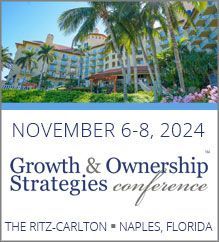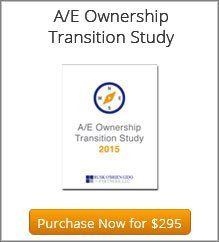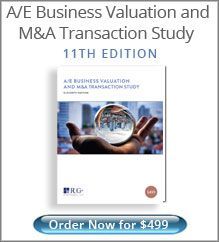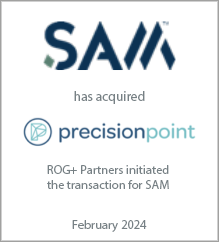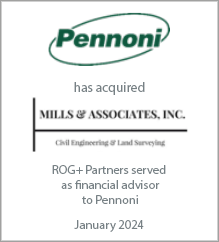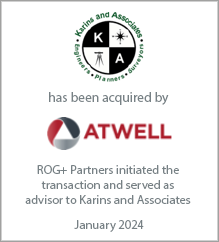Steve Gido specializes in corporate financial advisory services with a focus on mergers and acquisitions. Steve has assisted architecture, engineering, environmental consulting and construction firms of all sizes across North America achieve their growth or liquidity goals through successful mergers & acquisitions. Steve has over 15 years of investment banking experience and holds the chartered financial analyst (CFA) designation from the CFA Institute.
Five Takeaways on 2022 A/E M&A Activity
December 13, 2022
Looking back over the past twelve months, you have to give credit to industry leaders navigating increasingly stormy seas. Generational talent shortages and elevated backlogs ("more work than we can handle") have marked 2022 as substantial federal infrastructure programs (IIJA, IFR, CHIPS) took shape. With pandemic concerns receding, executives pivoted to confront persistent inflation, evolving workforce models, and soaring interest rates while wondering if we're in store for a rough recession or perhaps a "soft landing." Yet, despite this worrisome backdrop, the resilient A/E industry will again witness a record year of revenue and profitability. In fact, 2022 will also reflect a banner period for M&A activity.
By our tabulations, we'll see North American transactions tick up 3% over last year's frenetic levels. Driven by emboldened strategic buyers and private equity investors, it's evident we're in the midst of a dynamic, structural realignment era. Firms are absorbing each other not to solve acute hiring challenges but for size and scale. A/E Principals everywhere are assessing their best ownership and governance model given chronic succession issues, looming redemption liabilities, technological advancements, and fierce competition scouring for seasoned employees and new clients.
For a big country like ours, watching this new landscape unfold has been breathtaking in a geographical sense. Nearly 25% of all 2022 transactions took place in either Texas or Florida, continuing a long-running trend as the "new roads and rooftops" growth mentality rolls on. Preferred destination states like Colorado, North Carolina, Georgia, or Arizona have also seen dozens of prominent A/E firms align with enthusiastic out-of-state suitors as the industry chessboard for market share plays out. Of course, cultural and integration risks always loom larger at the intersection of national or regional growth ambitions with the uniqueness of local markets and economies.
Key A/E M&A takeaways include the following:
1. Today's activity is led by a concentrated group of buyers – Approximately 30 A/E firms, most of them publicly traded or private equity backed, were responsible for 30% of this year's transactions. Spanning all disciplines, these serial buyers include established and start-up names such as Ardurra Group, Salas O'Brien, Bowman, J.S. Held, DCCM, WSP, TRC, IMEG, and Trilon Group. Active acquirers often possess formal in-house M&A teams and can run efficient processes, from early courtship to the offer, due diligence, closing, and integration stages.
2. Leaders are responding to unsolicited approaches and offers – Our observation is that more owners are open to a sale discussion initiated by a viable and like-minded suitor. And it's not just for company fiduciary or protocol purposes. While often conveying a commitment to independence and "going it alone," this environment has prodded several A/E leaders to at least entertain conversations. In most instances, the inquiry resonated due to internal transition concerns or resource deficiencies, the cultures and synergies aligned, or the valuation proposition was too good to pass up.
3. The private equity phenomenon shows no signs of letting up – As we've highlighted previously, the accelerated influence of private equity into a variety of A/E firms has been the most intriguing and impactful ownership model development in decades. And this year was no different as several well-known companies, from Geosyntec Consultants, Core States Group, GAI Consultants, Huckabee, LJB, PaleoWest, Arora Engineers, and Integral Consulting, to name a few, all recapitalized with financial sponsors. A similar model has emerged whereby several unrelated design firms of comparable sizes join forces sequentially under a newly established identity and investor. But what's next? In short order, given finite investment horizons, we'll start to see many A/E firms seek their second recapitalization event. They'll swap one private equity firm for a new one or sell outright to another investor-backed platform.
4. Surprisingly, employee-owned firms are selling – ESOPs have long been a prevalent A/E ownership model. Selling owners have been able to transition equity and maintain their independence while creating a new employee benefit for staff retention and motivation. But more ESOP firms sell outright to larger strategic buyers and private equity investors year after year. What's driving this? A combination of factors, including: the ESOP directly benefitted an ownership team a generation ago but seems ineffective today; mid-sized firms with ESOPs still face "squeeze" dilemmas in competing with both larger design firms and smaller boutiques; and the ongoing oversight needed to review ESOP repurchase obligations.
5. Earnouts are back, for better or worse – In M&A transactions, earnouts are a future pay-for-performance consideration based on metrics that the parties agree to. When skillfully utilized, they can bridge valuation gaps and create a short-term motivational tool, so sellers continue to have "skin in the game" after the deal closes. They are common in A/E and other professional services acquisitions; in our experience, some buyers like them, and others don't. Earnouts have the risk of creating an "us vs. them" mindset to harmonious integration, mainly if the buyer operates with a one-profit center model. We see more earnouts primarily due to the "hockey stick" pattern of sellers' post-pandemic lofty performance. Will those results continue? Are good times an aberration due to one-time factors, or can these levels be sustained? Parties should expect earnouts as part of the term sheet framework, especially if the odds of a severe recession rise.
***
At ROG+ Partners, we possess strong relationships and years of experience navigating A/E and environmental buyers and sellers through the M&A process and toward winning combinations. Whether you are seeking to grow through acquisition or are evaluating your firm's strategic and ownership alternatives, please get in touch with us about how we can help your organization.
We are pleased to have assisted our clients with the following recent M&A transactions: https://www.rog-partners.com/transactions.
On a final note, Season's Greetings and a happy, healthy, and prosperous New Year from all of us here at ROG!
Latest Perspective
Perfecting the A/E Exit Strategy – Five Key Factors
An enormous A/E generation that kicked off their careers in the 1980s and subsequently started firms or became owners in the 1990s ...
Rusk O'Brien Gido + Partners, LLC


